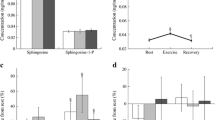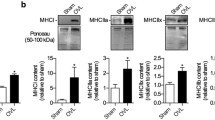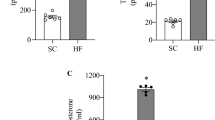Abstract
Human muscle is studied during glycogen depletion and repletion to understand the influence of exercise and muscle glycogen on total ceramide content. In addition, fiber-type-specific ceramide storage is investigated. Ten healthy males (26.4 ± 0.9 years, BMI 24.4 ± 0.7 kg m−2 and VO2max 57 ± 2 mL O2 min−1 kg−1) participated in the study. On the first day, one leg was glycogen-depleted (DL) by exhaustive intermittent exercise followed by low carbohydrate diet. Next day, in the overnight fasted condition, muscle biopsies were excised from vastus lateralis before and after exhaustive exercise from both DL and control leg (CL). Muscle glycogen was analyzed biochemically and total muscle ceramide content by 2D quantitative lipidomic approach. Furthermore, fiber-type ceramide content was determined by fluorescence immunohistochemistry. Basal muscle glycogen was decreased (P < 0.05) with 50 ± 6% in DL versus CL. After exhaustive exercise, muscle glycogen was similar in CL and DL 139 ± 38 and 110 ± 31 mmol kg−1, respectively. Total muscle ceramide 58 ± 1 pmol mg−1 was not influenced by glycogen or exercise. Ceramide content was consistently higher (P < 0.001) in type I than in type II muscle fibers. In conclusion, human skeletal muscle, ceramide content is higher in type I than in type II. Despite rather large changes in muscle glycogen induced by prior depletion, exercise to exhaustion and repletion, total muscle ceramide concentration remained unchanged.




Similar content being viewed by others
References
Adams JM, Pratipanawatr T, Berria R, Wang E, DeFronzo RA, Sullards MC, Mandarino LJ (2004) Ceramide content is increased in skeletal muscle from obese insulin-resistant humans. Diabetes 53(1):25–31
Andersen JL, Aagaard P (2000) Myosin heavy chain IIX overshoot in human skeletal muscle. Muscle Nerve 23(7):1095–1104
Andersen P, Adams RP, Sj¢gaard G, Thorboe A, Saltin B (1985) Dynamic knee extension as model for study of isolated exercising muscle in humans. J Appl Physiol 59(5):1647–1653
Andersen JL, Schjerling P, Andersen LL, Dela F (2003) Resistance training and insulin action in humans: effects of de-training. J Physiol 551(Pt 3):1049–1058
Bergström J (1962) Muscle electrolytes in man: determined by neutron activation analysis on needle biopsy specimens. A study on normal subjects, kidney patients and patients with chronic diarrhea. Scand J Clin Lab Invest Suppl 68:11–13
Blachnio-Zabielska A, Baranowski M, Zabielski P, Gorski J (2008) Effect of exercise duration on the key pathways of ceramide metabolism in rat skeletal muscles. J Cell Biochem 105(3):776–784
Bruce CR, Thrush AB, Mertz VA, Bezaire V, Chabowski A, Heigenhauser GJ, Dyck DJ (2006) Endurance training in obese humans improves glucose tolerance, mitochondrial fatty acid oxidation and alters muscle lipid content. Am J Physiol Endocrinol Metab 291:E99–E107
Burke LM, Angus DJ, Cox GR, Cummings NK, Febbraio MA, Gawthorn K, Hawley JA, Minehan M, Martin DT, Hargreaves M (2000) Effect of fat adaptation and carbohydrate restoration on metabolism and performance during prolonged cycling. J Appl Physiol 89(6):2413–2421
Chabowski A, Baranczuk E, Gorski J (2005) Effect of adrenalin, insulin and contractions on the content of the free fatty acid fraction in skeletal muscle. J Physiol Pharmacol 56(3):381–390
Dobrzyn A, Gorski J (2002a) Effect of acute exercise on the content of free sphinganine and sphingosine in different skeletal muscle types of the rat. Horm Metab Res 34(9):523–529
Dobrzyn A, Gorski J (2002b) Ceramides and sphingomyelins in skeletal muscles of the rat: content and composition: effect of prolonged exercise. Am J Physiol Endocrinol 282(2):E277–E285
Dobrzyn A, Zendzian-Piotrowska M, Gorski J (2004) Effect of endurance training on the sphingomyelin-signalling pathway activity in the skeletal muscles of the rat. J Physiol Pharmacol 55(2):305–313
Dobrzyn A, Dobrzyn P, Lee SH, Miyazaki M, Cohen P, Asilmaz E, Hardie DG, Friedman JM, Ntambi JM (2005) Stearoyl-CoA desaturase-1 deficiency reduces ceramide synthesis by downregulating serine palmitoyltransferase and increasing beta-oxidation in skeletal muscle. Am J Physiol Endocrinol Metab 288(3):E599–E607
Ejsing CS, Duchoslav E, Sampaio J, Simons K, Bonner R, Thiele C, Ekroos K, Shevchenko A (2006) Automated identification and quantification of glycerophospholipid molecular species by multiple precursor ion scanning. Anal Chem 78(17):6202–6214
Ekroos K, Chernushevich IV, Simons K, Shevchenko A (2002) Quantitative profiling of phospholipids by multiple precursor ion scanning on a hybrid quadrupole time-of-flight mass spectrometer. Anal Chem 74(5):941–949
He J, Watkins S, Kelley DE (2001) Skeletal muscle lipid content and oxidative enzyme activity in relation to muscle fiber type in type 2 diabetes and obesity. Diabetes 50(4):817–823
Helge JW, Richter EA, Kiens B (1996) Interaction of training and diet on metabolism and endurance during exercise in man. J Physiol (Lond) 292:293–306
Helge JW, Stallknecht B, Pedersen BK, Richter EA, Galbo H, Kiens B (2003) IL-6 release during one leg exercise-intensity and glucose uptake. J Physiol 546(pt1):299–305
Helge JW, Dobrzyn A, Saltin B, Gorski J (2004) Exercise and training effects on ceramide metabolism in human skeletal muscle. Exp Physiol 89(1):119–127
Itani SI, Ruderman NB, Schmieder F, Boden G (2002) Lipid-induced insulin resistance in human muscle is associated with changes in diacylglycerol, protein kinase C, and IkappaB-alpha. Diabetes 51(7):2005–2011
James D, Jenkins A, Kraegen E (1985) Heterogeneity of insulin action in individual muscles in vivo: euglycemic clamp studies in rats. Am J Physiol 248:E567–E574
Larsen S, Ara I, Rabol R, Andersen JL, Boushel R, Dela F, Helge JW (2009) Are substrate use during exercise and mitochondrial respiratory capacity decreased in arm and leg muscle in type 2 diabetes? Diabetologia 52(7):1400–1408
Malenfant P, Tremblay A, Doucet E, Imbeault P, Simoneau JA, Joanisse DR (2001) Elevated intramyocellular lipid concentration in obese subjects is not reduced after diet and exercise training. Am J Physiol Endocrinol 280(4):E632–E639
Radegran G, Blomstrand E, Saltin B (1999) Peak muscle perfusion and oxygen uptake in humans: importance of precise estimates of muscle mass. J Appl Physiol 87(6):2375–2380
Serlie MJ, Meijer AJ, Groener JE, Duran M, Endert E, Fliers E, Aerts JM, Sauerwein HP (2007) Short-term manipulation of plasma free fatty acids does not change skeletal muscle concentrations of ceramide and glucosylceramide in lean and overweight subjects. J Clin Endocrinol Metab 92(4):1524–1529
Skovbro M, Baranowski M, Skov-Jensen C, Flint A, Dela F, Gorski J, Helge JW (2008) Human skeletal muscle ceramide content is not a major factor in muscle insulin sensitivity. Diabetologia 51(7):1253–1260
Stefanini M, De MC, Zamboni L (1967) Fixation of ejaculated spermatozoa for electron microscopy. Nature 216(5111):173–174
Straczkowski M, Kowalska I, Nikolajuk A, Dzienis-Straczkowska S, Kinalska I, Baranowski M, Zendzian-Piotrowska M, Brzezinska Z, Gorski J (2004) Relationship between insulin sensitivity and sphingomyelin signaling pathway in human skeletal muscle. Diabetes 53(5):1215–1221
Straczkowski M, Kowalska I, Baranowski M, Nikolajuk A, Otziomek E, Zabielski P, Adamska A, Blachnio A, Gorski J, Gorska M (2007) Increased skeletal muscle ceramide level in men at risk of developing type 2 diabetes. Diabetologia 50(11):2366–2373
Summers SA (2006) Ceramides in insulin resistance and lipotoxicity. Prog Lipid Res 45(1):42–72
Vistisen B, hellgren lI, Vadset T, Scheede-Bergdahl C, Helge JW, Dela F, Stallknecht B (2008) Effect of gender on lipid-induced insulin resistance in obese subjects. Eur J Endocrinol 158(1):61–68
Wieland O (1974) Glycerol assay. In: Bergmeyer HV (ed) Methods of enzymatic analysis. Academic Press, New York, pp 1404–1406
Zendzian-Piotrowska M, Baranowski M, Zabielski P, Gorski J (2006) Effects of pioglitazone and high-fat diet on ceramide metabolism in rat skeletal muscles. J Physiol Pharmacol 57(Suppl 10):101–114
Acknowledgments
Financial support was received from the Velux Foundation, the Lundbeck Foundation, the Novo Nordisk Foundation, The Foundation of 1870, Direktør Jacob and Olga Madsens Foundation, Aase and Ejnar Danielsens foundation and Astra Zeneca. Furthermore, we thank Thomas Beck, Jeppe Bach, Steen Larsen and Regitze Kraunsøe for providing excellent technical assistance.
Conflict of interest statement
None.
Author information
Authors and Affiliations
Corresponding author
Additional information
Communicated by Jacques Poortmans.
Rights and permissions
About this article
Cite this article
Nordby, P., Prats, C., Kristensen, D. et al. Muscle ceramide content in man is higher in type I than type II fibers and not influenced by glycogen content. Eur J Appl Physiol 109, 935–943 (2010). https://doi.org/10.1007/s00421-010-1428-4
Accepted:
Published:
Issue Date:
DOI: https://doi.org/10.1007/s00421-010-1428-4




